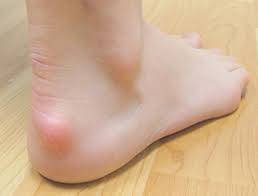Retrocalcaneal bursitis
Retrocalcaneal bursitis treatment at Colgan Osteopathy Kettering

Retrocalcaneal bursitis is one of the most common causes of heel pain. Retrocalcaneal bursitis is in inflammation of the bursa located between the calcaneus and the anterior surface of the Achilles tendon. Bursitis is the inflammation of a bursa. There are two bursae located at the insertion of the Achilles tendon. Inflammation of either or both of these bursa can cause pain at the posterior heel and ankle region.
- Deep to the tendon is the retrocalcaneal bursa, which is located between the Achilles tendon and the calcaneus.
- Superficial to the Achilles tendon is the subcutaneous calcaneal bursa. This bursa is located between the skin and Achilles tendon.
It is also known as Achilles tendon bursitis. It can often be mistaken for Achilles Tendinopathy or can also occur together with Achilles tendinopathy.
Clinical Anatomy and pathogenesis
A Bursa is located at a junction of a tendon on the bone. A bursa is a “bag” filled with a thin layer of synovial fluid. The key concept is that at this site the tendon insertion, the bursa and the bone are so intimately related that a prominence of the calcaneum will greatly predispose to mechanical irritation of the bursa and the tendon. Also, there is significant strain on the tendon insertion on the posterior aspect of the tendon with dorsiflexion.

Epidemiology
Retrocalcaneal bursitis is common in both the sporting athlete and the general population. In normal population its incidence is high in individuals who are accustomed to wearing high-heeled shoes on a long-term basis and may experience increased stretch and irritation of the Achilles tendon and its associated bursae when switching to flat shoes.
Causes
A retrocalcaneal bursa mat occur traumatically from a fall or a sport related impact contusion or it can also present as a gradual onset due to repetitive trauma to the bursa from activities including running or excessive loading.
- Overtraining in an athlete
- Tight or poorly fitting shoes that produce excessive pressure at the posterior heel
- Haglund deformity
- Altered joint axis
Inflammation of the calcaneal bursae is most commonly caused by repetitive (cumulative) trauma or overuse, and the condition is aggravated by pressure, such as when athletes wear tight-fitting shoes. In some cases, retrocalcaneal bursitis may be caused by bursal impingement between the Achilles tendon and an excessively prominent posterosuperior aspect of the calcaneus (Haglund deformity). In Haglund disease, impingement occurs during ankle dorsiflexion.

Sign and Symptoms
- Pain at the back of the heel, especially when running uphill
- Pain may get worse when rising on the toes (standing on tiptoes)
- Tenderness at the back of heel
- Swelling at the back of heel
- Increase in pain in activities which load the calf
Clinical Assessment
A good clinical practise includes evaluation of the tendon, bursa and calcaneum by, careful history, inspection of the region for bony prominence and local swelling as well as palpation of the area of maximal tenderness. Biomechanical abnormalities, joint stiffness and proximal soft tissue tightening can exacerbate an anatomical predisposition to retrocalcaneal bursitis, they warrant correction when present.
Magnetic resonance imaging (MRI) may demonstrate bursal inflammation, but this modality probably does not offer much more information than that found by careful physical examination. Theoretically, MRI could help the physician to determine whether the inflammation is within the subcutaneous bursa, the subtendinous bursa, or even within the tendon itself; however, such testing is generally not necessary.
Differential Diagnosis
- Posterior ankle impingment
- Haglund deformity
- Achilles tendonitis
- partial rupture achilles tendon
- Plantarfasicitis
Treatment
The patient with retrocalcaneal bursitis should be instructed to apply ice to the posterior heel and ankle in the acute period of the bursitis. Icing can be performed several times a day, for 15-20 minutes each. Some clinicians also advocate the use of contrast baths.

Gradual progressive stretching of the Achilles tendon may help relieve impingement on the subtendinous bursa and can be performed in the following manner:
- Stand in front of a wall, with the affected foot flat on the floor. Lean forward toward the wall until a gentle stretching is felt within the ipsilateral Achilles tendon.
- Maintain the stretch for 20-60 seconds and then relax.
- Perform the stretches with the knee extended and then again with the knee flexed.
- To maximize the benefit of the stretching program, repeat the above steps for several stretches per set, several times daily. Avoid ballistic (ie, abrupt, jerking) stretches.
Colgan Osteopathy in Kettering is located @Knead It Sport Clinic
Address: 4 Market Mews, Market Street, Kettering, NN16 0AH Press here for map
Call us to see how we can help 07738493974 or book online
